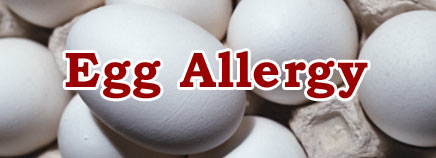



Many young children experience egg allergy, but the condition is less common among adults. Many children usually outgrow it, but problems can occur because it is sometimes difficult to recognize. Egg allergy symptoms in adults may arise when they eat food products that contain eggs, especially when their labels do not clearly indicate them as an ingredient. A list of food products with eggs is given in this article to help you get an egg-free diet.
Allergy to eggs is extremely rare among adults. Egg allergy symptoms in adults usually begin in childhood or during early adulthood. They usually manifest only as mild nausea or flaring of skin inflammation (eczema) after eating a food product that contains egg. These symptoms may include:
An overreaction of the immune system may occur after eating an allergen, such as egg protein, which triggers the release of chemicals called histamine. This immune system malfunction mistakes egg proteins to be harmful, and sends antibodies and histamine to fight or neutralize them. This causes a chain reaction that leads to your allergic symptoms.
Factors that increase your risk of developing egg allergy include family history of allergy to eggs, a personal medical history of allergies, and young age. Children usually outgrow their egg allergy, but in some the condition the allergy persists to adulthood.
There is no cure for egg allergy, and there is no way to prevent an allergic reaction to egg. However, you can prevent the egg allergy symptoms by avoiding eggs or foods that contain eggs. Here are some ways to ease your symptoms.
The only way to prevent egg allergy symptoms in adults is to avoid eating them as well as all egg-containing foods, since you may be allergic to the yolk, the egg white, or both.
|
Foods That Could Contain Eggs |
||||
|
Eggnog, eggrolls |
Fizzes |
Baked foods |
Caesar salad |
Ice cream
|
|
Egg substitutes |
Mayonnaise |
Marshmallows |
Pastas |
Soufflés
|
|
Sauces |
Breaded foods /batter-fried foods |
Cream pies, puffs and fillings |
Crepes , waffles |
Custards and puddings |
|
Coffee drinks with foam |
Lollipops and candies |
Meringue, frostings |
Meatloaf, meatballs |
Soups, consommés |
It is important for you to read food labels and lists of ingredients carefully, and to ask about them at restaurants. Do not eat the food if you are not sure it’s egg-free.
|
Ingredients on Labels to Watch Out For |
||||
|
Bran |
Bulgur |
Bread crumbs |
Couscous |
Club wheat |
|
Cracker meal |
Graham flour |
Durum farina |
Farina |
Spelt |
|
Pasta |
Wheat |
Flour |
Semolina |
Wheat grass |
|
Wheat germ, wheat starch |
Whole-wheat berries |
Einkorn, emmer, kamut, seitan |
Modified food starch |
Matzoh, matzo meal |
|
Triticale |
Vital gluten |
Soy sauce |
Starch |
Hydrolyzed protein |
|
Egg Substitute |
Why Use It |
|
¼ cup tofu |
It has a texture similar to cooked eggs. |
|
2 tsp. baking powder, 2 tsp. water and 1 tbsp. canola oil |
Baking powder is for the leavening, while water and oil are substitutes for the liquid and fat of egg. |
|
3 tbsp. fruit purees (applesauce/banana/pumpkin) |
Fruits contain pectin, which acts like fat and holds the air bubbles in your batter. |
|
Acid (vinegar/ buttermilk/ lemon juice) plus baking soda |
Acid plus base produces a chemical reaction that results in gas bubbles which leaven the dough. |
|
3 tbsp. chickpea flourplus 3 tbsp. water |
Chickpea flour acts as a binder because of its high protein content. |